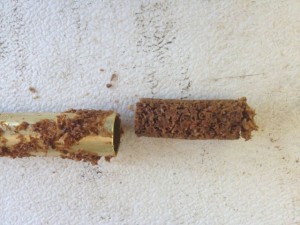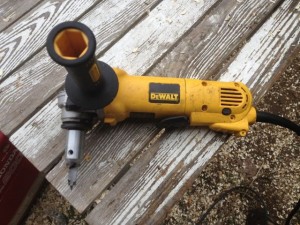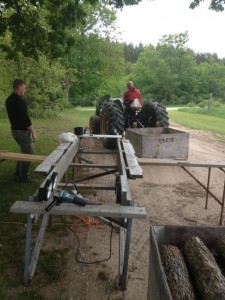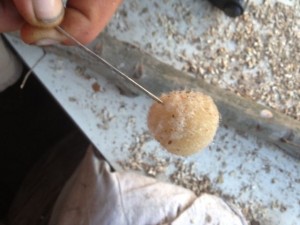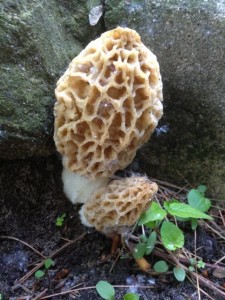 Northwest Michigan is something of a mushroom paradise. This spring, I’ve already enjoyed several different foraged mushroom species: morel (Morchella spp.), dryad’s saddle (aka pheasant’s back, Polyporus squamosus, which is not considered a choice edible, but is worth trying), and oyster mushrooms (Pleurotus spp.). And I got to enjoy the first shiitake (Lentinula edodes) harvested at Two Fish Farms from logs inoculated last year.
Northwest Michigan is something of a mushroom paradise. This spring, I’ve already enjoyed several different foraged mushroom species: morel (Morchella spp.), dryad’s saddle (aka pheasant’s back, Polyporus squamosus, which is not considered a choice edible, but is worth trying), and oyster mushrooms (Pleurotus spp.). And I got to enjoy the first shiitake (Lentinula edodes) harvested at Two Fish Farms from logs inoculated last year.
I’ve also had the opportunity to work at two local farms inoculating logs with mushroom spawn this season. Shiitake is the primary species being produced on logs in the area, but several other species are suitable for log culture as well.
Mushrooms are an ideal crop to investigate for Permaculture applications. They can be excellent for recycling thinnings from forests and hedgerows into an excellent edible or medicinal harvest. Multiple species can be grown on pasteurized or soaked straw or wood chips, as well. Oyster mushrooms can even be grown on newspaper or used coffee grounds.
The first mushroom inoculation project was cooperative between Two Fish Farms and Five Springs Farms. John (co-owner of Two Fish Farms) and I helped with inoculation in exchange for a share of the inoculated logs.
Though I’ve done quite a bit of reading and research on outdoor mushroom cultivation (I recently came across a folder of shiitake cultivation info I collected in 1988…), this was my first hands-on experience inoculating logs.
It’s a straightforward process. There are three components — drilling, inoculating, and waxing.
Wooden dowels colonized by mushroom mycelia (called plug spawn) used to be the primary way logs were inoculated, and this method is still used today. However, many mushroom growers are now using sawdust spawn (sawdust colonized by mycelia) for log inoculation. Sawdust spawn usually has a higher success rate than plug spawn, and may be somewhat faster to work with than plug spawn.
When inoculating logs with sawdust spawn, a plunger tool is used to create a plug of spawn that fills the drilled holes.
A new technique for drilling holes, instead of using a standard drill, is to use an angle grinder adapter (available at Field & Forest Products) to attach a drill bit with a stop to an angle grinder, creating a high speed drill. This system makes drilling logs quite fast and easy.
The second inoculation project was at Ware Farm, owned by Bernie and Sandy Ware, just down the road from Two Fish Farms. Bernie converted the farm to organic from conventional methods, and shiitake mushrooms are one of the farm’s main crops.
Ware Farm has an excellent setup for inoculation and regularly hosts workshops on mushroom log culture. They use a long table which can be set up with multiple inoculation positions as needed. At each end there are two pairs of wheels to allow logs to be rolled easily when drilling or waxing.
Logs used for inoculation at both farms were a mixture of oak and maple, in 3-4′ lengths. Most were 2-5″ in diameter. Logs are typically cut in late winter and inoculated in late spring to early summer.
Drilled logs are put in the middle of the table, for easy access to inoculation stations. After inoculation, they return to the middle of the table until they are ready for waxing.
The wax is used to seal the exposed surface of the sawdust spawn, to ensure that it does not dry out. Cheese wax is used, due to its relatively low melting point (though it can be heated to higher temperatures than parafin wax). It is typically applied with a small paint brush, a small foam brush, or a wool ball.
It is important to use a safe heating system (ideally a small crock pot or double boiler) to keep the wax at the proper temperature (it should be lightly smoking only), so the wax flows and absorbs into the logs properly. Note that this wax can be flammable if overheated, and care should be used when heating it. The wax and heater should be located where they cannot accidentally be spilled by logs or workers.
Uniformity in log length helps keep the whole process efficient, though Bernie also likes to inoculate some “artistic” logs (multi-branched and “y” shaped logs) to used for displays when he goes to market. These are slower and more challenging to drill, inoculate, and wax, but the extra effort pays off in an attractive, attention-getting display piece.
Ware farm uses a number of different shiitake varieties, including warm weather fruiting, cool weather fruiting, and season long fruiting strains. This allow for an extended harvest season.
All sawdust spawn was sourced from Field & Forest Products, a highly recommended supplier in Wisconsin. Across both projects, a total of four varieties of shiitake were used:
- Bellweather – a cool season fruiting strain, producing in spring (primarily) and in fall.
- Native Harvest – originated as a naturalized population at Field & Forest in Wisconsin and is a wide range fruiter.
- WR46 – a wide range fruiter with a very rapid colonization and strong initial mushroom production. An excellent strain for first time growers.
- West Wind – a vigorous strain that prefers red oak, but is suitable for other species. Fast to colonize and heavy yielding. Considered a good choice for new growers.
In addition to shiitake, we inoculated three other species at Five Springs Farm:
- Italian oyster – Pleurotus pulmonarius, a mild, thick strain with brown caps and white stems
- Reishi– Ganoderma lucidum, generally best for more southerly locations, this is an experiment in this climate. We may need to move them to protected areas for fruiting.
- Lions mane (Hericium erinaceus) – a choice edible found wild growing on live trees, but increasingly being cultured.
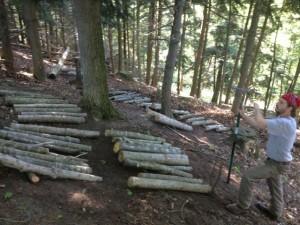 After logs are inoculated, they are put in a colonization yard. This is a shaded (ideally with both an upper and lower canopy), wind protected spot. Ideally, the site should be 80 to 85% shaded. Shade helps to ensure that the logs remain moist while the mushroom spawn grows throughout the logs.
After logs are inoculated, they are put in a colonization yard. This is a shaded (ideally with both an upper and lower canopy), wind protected spot. Ideally, the site should be 80 to 85% shaded. Shade helps to ensure that the logs remain moist while the mushroom spawn grows throughout the logs.
After the logs are fully colonized with mycelia, they are usually moved to a fruiting area. Colonization typically takes 1-2 years, depending on mushroom species and wood type. Mushroom production can continue for 2-5 years or more, again depending on species and wood type.

